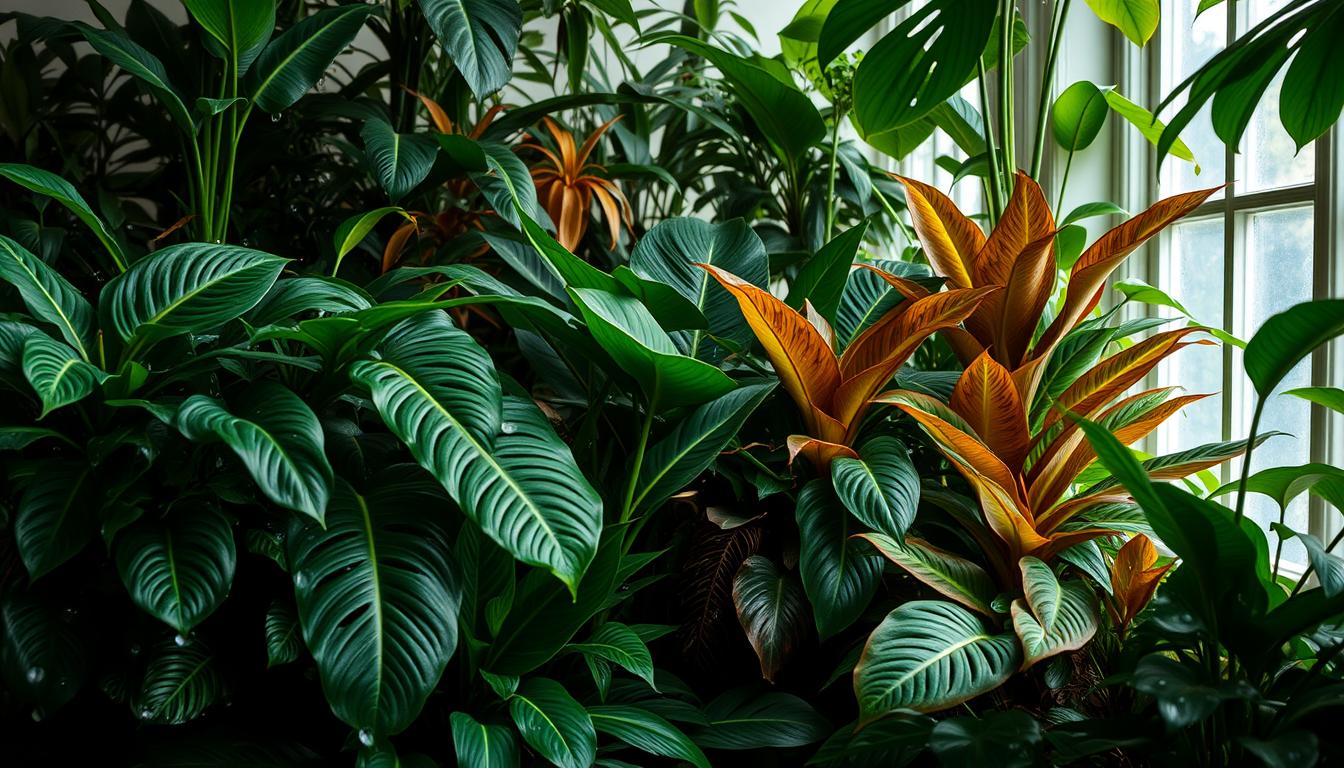Keeping the right humidity level is key for tropical houseplants to stay healthy and grow well. These plants love moist air, just like their natural rainforest homes. The right air moisture can make the difference between green, lively leaves and dry, brown ones.
Key Takeaways
- Humidity is the relative amount of water vapor in the air, typically measured on a scale of 0% to 100%.
- Ideal humidity for most homes is between 30-50%, but tropical houseplants need higher levels of 50-60%.
- Maintaining proper humidity prevents common issues like leaf browning and improves overall plant health and growth.
- Using a humidifier, grouping plants together, and misting are effective ways to increase humidity for indoor tropicals.
- Monitoring humidity levels and making adjustments as needed is key to creating the optimal environment for tropical houseplants.
Understanding Humidity for Indoor Plants
Keeping the right humidity levels is key for tropical houseplants to stay healthy and grow well. Humidity is how much water vapor is in the air. It’s important for these plants that love moisture. When it gets hotter, the air can hold more water vapor. This is measured on a scale from 0% (dry) to 100% (fully saturated).
What is Humidity?
The Mayo Clinic says your home should have humidity between 30% and 50%. Most houseplants do well in these levels. But, tropical houseplants need more humidity, around 50-60%. This helps them feel like they’re back in the rainforest.
Humidity Requirements for Tropical Houseplants
It’s crucial to keep the humidity right for tropical plants to grow and stay healthy. Plants like monstera deliciosa, philodendrons, and calatheas need high humidity to thrive. The right humidity stops problems like leaf curling and stunted growth.
| Plant Type | Ideal Humidity Range |
|---|---|
| Common Houseplants | 30% – 50% |
| Tropical Houseplants | 50% – 60% |
Knowing what humidity tropical plants need helps gardeners create the best environment. This way, these plants can grow strong and stay healthy.
Signs of Low or High Humidity Levels
Keeping the right humidity is key for tropical houseplants’ health and vitality. Low and high humidity can harm your indoor plants. Let’s look at the signs of each to spot and fix humidity issues.
Symptoms of Low Humidity
If your tropical plants have low humidity, watch for these signs:
- Shriveling or curling leaves
- Browning or crisping of leaf edges
- Leaf scorch, where the leaves appear dried out and damaged
- Wilting leaves and stems, even when the potting mix is moist
These signs mean your plants lack enough moisture in the air. This can cause dehydration and slow growth. It’s important to create a more humid environment to prevent these issues and encourage healthy growth.
Symptoms of High Humidity
High humidity can cause these problems in indoor plants:
- Mold or mildew growth on the plant, the planter, or the potting soil surface
- Fungal infections, such as root rot or leaf spots
- Yellowing leaves, which can also be a sign of overwatering due to the moist soil and lack of airflow preventing proper drying
High humidity, especially with poor air flow, can lead to harmful fungi and bacteria. This can cause plant health issues. It’s important to manage high humidity to keep your tropical indoor garden healthy.
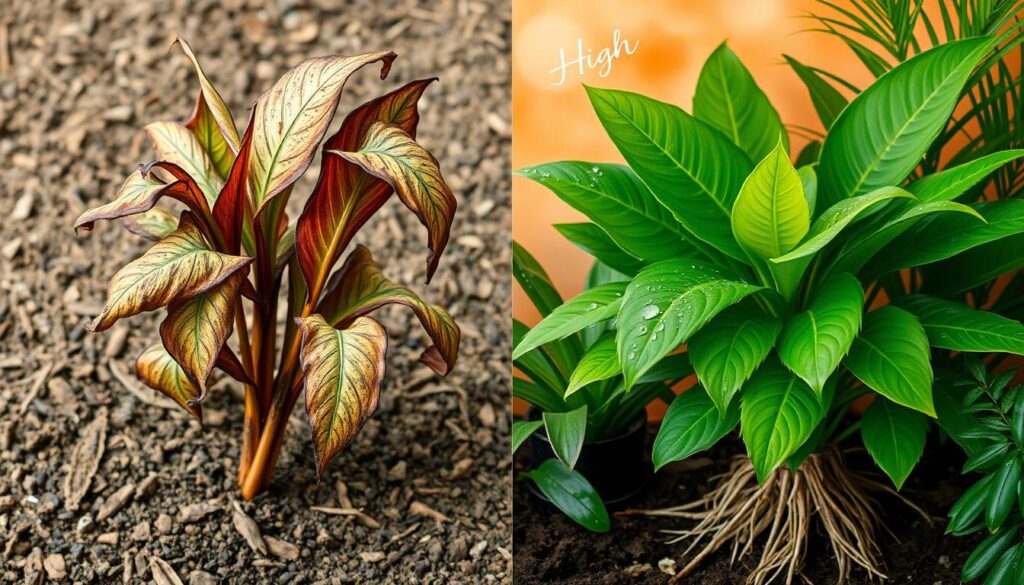
Knowing the signs of low and high humidity helps you take steps to keep your home’s moisture right. This ensures your tropical houseplants do well. The right balance is crucial for lush, healthy growth and a thriving indoor garden.
7 Ways to Increase Humidity for Houseplants
Keeping tropical houseplants healthy means keeping the right humidity levels. There are many ways to boost air moisture for your plants. From humidifiers to grouping plants, let’s look at 7 methods to increase humidity for your indoor garden.
Utilize a Humidifier
Using a humidifier is an easy way to increase humidity. Tabletop or room humidifiers can greatly improve air moisture. This helps plants that love humidity and prevents wilting leaves and supports plant health.
Group Plants Together
Grouping houseplants together creates a microclimate that raises humidity. As plants release water vapor, it builds up around them. This is great for moisture-loving species like ferns and tropicals.
Use Pebble Trays
Putting your plants on pebble trays filled with water is a budget-friendly way to add humidity. As the water evaporates, it makes the air and soil around the plants more moist. This is perfect for houseplants that need a humid environment.
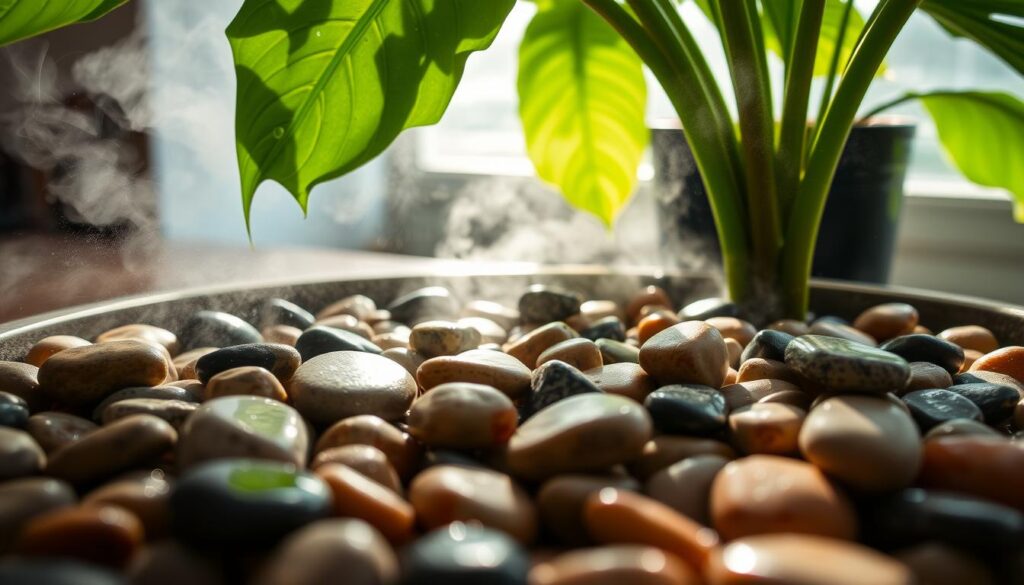
“Maintaining the right humidity levels is crucial for the long-term health and growth of many tropical houseplants.”
Using these strategies together can create the best environment for your indoor garden. With a bit of effort, your houseplants will get the humidity they need to stay healthy and look great.
The Importance of Humidity for Tropical Houseplants
Keeping the right humidity is key for tropical houseplants to stay healthy and grow well. These plants love the high moisture of rainforests and need more humidity than many houseplants. Without enough humidity, they can get leaf browning, wilt, get fungal infections, and grow poorly.
To make a great home for these plants, gardeners need to know their humidity needs. Using humidifiers and keeping plants close together are good ways to add moisture to the air. This helps tropical plants stay healthy and grow well.
The Benefits of Proper Humidity
- Preventing leaf browning and wilting
- Reducing the risk of fungal infections
- Promoting vigorous growth and lush foliage
- Enhancing the overall aesthetic appeal of tropical houseplants
Having the right humidity not only makes tropical plants look great but also keeps them healthy for a long time. By watching the air moisture and adjusting as needed, gardeners can make sure their tropical houseplants get the best environment to grow.
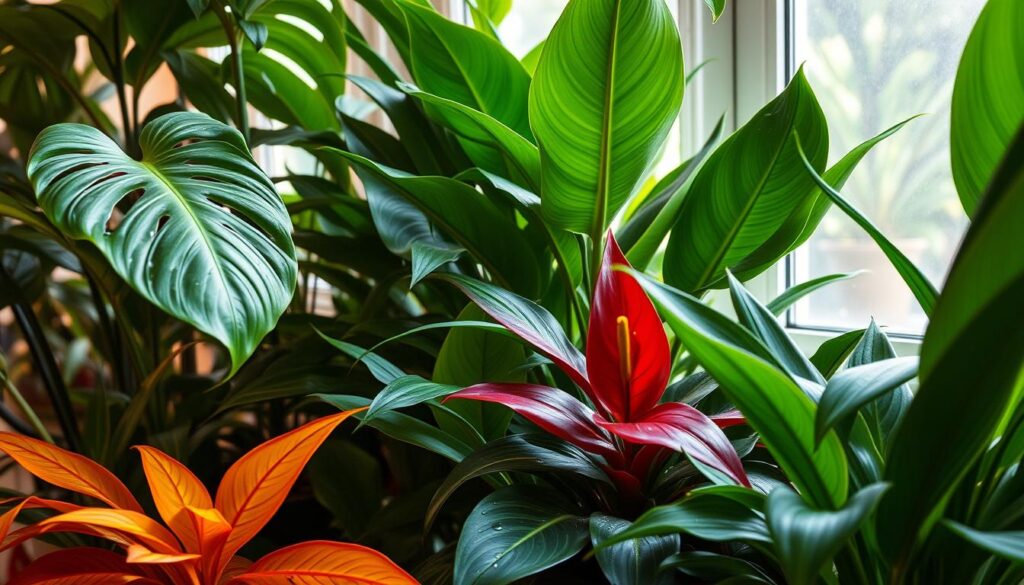
“Humidity is one of the most important factors for the success of tropical houseplants. Without proper moisture in the air, these plants will struggle to survive and reach their full potential.”
| Humidity Level | Impact on Tropical Houseplants |
|---|---|
| Low Humidity | Increased risk of leaf browning, wilting, and stunted growth |
| Proper Humidity | Lush, vibrant foliage, and optimal plant health |
| High Humidity | Potential for fungal diseases and other issues |
Maintaining Ideal Humidity Levels
Keeping the right humidity levels is key for your tropical houseplants’ health. Using humidifiers and pebble trays can up the air’s moisture. Misting houseplants also gives a quick moisture boost to the leaves. But, this method needs regular doing.
Putting moisture-loving species in humid spots like bathrooms or kitchens works well. These places have extra steam that’s good for the plants. Use a hygrometer to check humidity levels and adjust as needed. This way, your tropical houseplants will do great.
Misting Plants
Misting of houseplants regularly can up the humidity near the leaves. This helps with plant health and keeps potting soil moisture right. But, you’ll need to mist often since it’s not a lasting fix for humidity.
Placement in Humid Areas
Putting your moisture-loving species in humid spots at home works well. Bathrooms, laundry rooms, or kitchens are good places. The steam and humidity levels there help wilting leaves and make grouping plants flourish.
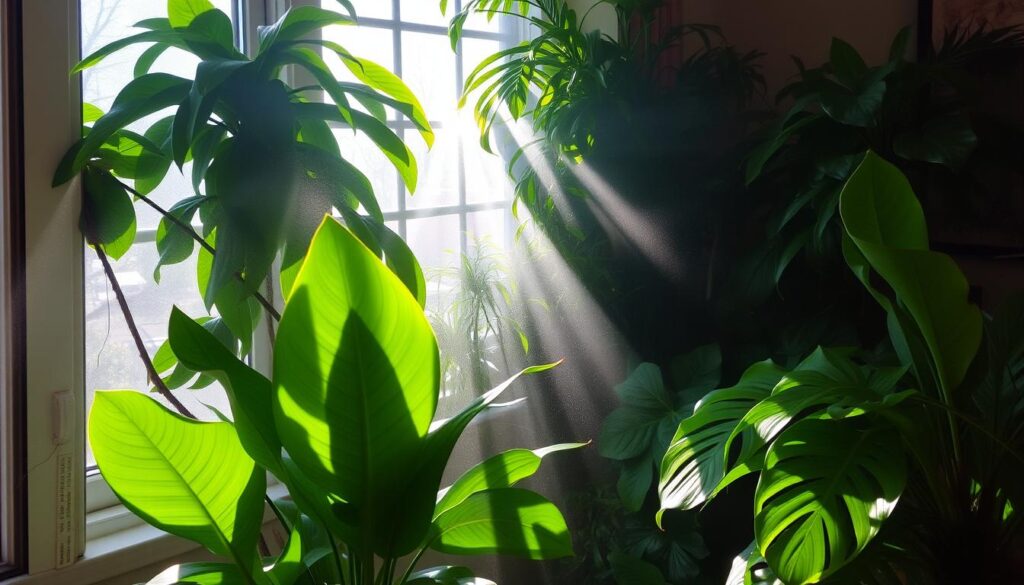
Temperature and Humidity Correlation
Keeping tropical houseplants happy is all about the right mix of temperature and humidity. These two factors work together to help your plants grow well. It’s key to get them just right for your plants to do their best.
Most tropical plants like it warm but not too warm. They do best in the day between 70-80°F and cool down to 60-68°F at night. This drop in temperature helps them recover and keeps them blooming longer. But, if the temperature swings too much, it can hurt your plants. They might grow slow, get damaged leaves, or even not survive.
Humidity is also super important for tropical houseplants. They don’t like it dry, or they might start to brown and curl. Getting the humidity right is key to making your plants look great and stay healthy.
| Environmental Factor | Ideal Range for Tropical Houseplants | Potential Issues with Deviation |
|---|---|---|
| Temperature | Daytime: 70-80°F Nighttime: 60-68°F | Stunted growth, foliage damage, plant failure |
| Humidity | 50-70% | Leaf browning, curling, and other health problems |
By keeping the right temperature and humidity, you can make your home feel like a tropical paradise. Your houseplants will love it and grow strong and healthy.
“Striking the right balance between temperature and humidity is the key to achieving lush, vibrant growth in your tropical houseplants.”
Conclusion
Keeping the right humidity is key for tropical houseplants to stay healthy and grow well. These plants need more moisture, usually 50-60% humidity, than most indoor plants. By using humidifiers, grouping plants, and placing them in humid spots, gardeners can make a great home for their tropical plants.
It’s also important to watch how temperature and humidity work together. Adjusting them as needed helps tropical houseplants grow lush and healthy indoors. This way, gardeners can make their homes feel like a rainforest, full of life and greenery.
This article covered how humidity helps tropical houseplants and the good things about misting techniques and humidifier use. It gave a full guide on making the best indoor plant environment and keeping proper humidity levels. Following these tips helps gardeners avoid leaf browning and boost improved plant growth. It also helps with air moisture monitoring and humidity adjustment tips for taking good care of tropical plants.
FAQ
Q: What is humidity and how is it measured?
A: Humidity is the amount of water vapor in the air. It ranges from 0% (dry) to 100% (completely saturated).
Q: What are the ideal humidity levels for tropical houseplants?
A: Tropical houseplants need humidity levels between 50-60%. This mimics their natural rainforest home. Keeping the right humidity helps them grow and stay healthy.
Q: What are the signs of low or high humidity for houseplants?
A: Low humidity can cause plants to have shriveled or curled leaves. They might also turn brown or crisp, get scorched, or wilt. Too much humidity can lead to mold or mildew on the plant or soil. It can also cause fungal infections.
Q: How can I increase humidity for my houseplants?
A: You can boost humidity with a humidifier, group plants, or use pebble trays with water. Misting plants with water is also effective.
Q: How do temperature and humidity impact tropical houseplants?
A: Temperature and humidity greatly affect tropical houseplants. Wrong temperatures can harm them. Indoor spaces often lack enough humidity, causing issues like leaf browning.


